
| BMW Garage | BMW Meets | Register | Search | Today's Posts | Mark Forums Read |
 |
|
|
 SUPPORT ZPOST BY DOING YOUR TIRERACK SHOPPING FROM THIS BANNER, THANKS! |
|||||||||
Post Reply |
|
|
Thread Tools | Search this Thread |
| 05-02-2018, 04:06 PM | #1 |
|
Lieutenant Colonel
 946
Rep 1,910
Posts |
The National Road (or, A Typical Tour of Defeat, Surrender, Scandal, and Murder)
After a long, wintertime layoff from touring, it was time to put aside the income taxes and get the valiant BMW 335i convertible back out on the road. My goal was to visit some new spots along the original National Road in western Maryland and southwestern Pennsylvania—and to break an automobile hill-climb record that has stood for 105 years. Along the way, I found a Half-King, a Half-Brother, and the usual amount of scandal, murder, and mayhem. What more could I ask for?  The Birth of the First National Road The National Road was the first improved highway built by the federal government. Its origins date back thousands of years. Native Americans used a trail to cross the Appalachian Mountains, travelling between the watershed of the Potomac River and that of the Monongahela via the Cumberland Narrows. In an effort to open up the Ohio Territory to Virginia settlers, the Ohio Company hired Colonel Thomas Cresap and his friend Nemacolin—a chief of the Delaware Indians—to widen the trail and make it passable by men on horses. They did so during 1749-1752, and ultimately this path became the first part of the National Road when it was built in 1811-1818. (Carl Rakeman drawing courtesy of the National Park Service.)  I made my trip on April 5, almost the start of Spring, but I ran into snow flurries even before I reached Frostburg, Maryland. Perhaps that’s inevitable with a town name like that. Regardless, it was only 23 degrees Fahrenheit, and extremely windy. At least I still had the Blizzaks on the BMW, just in case. My goal was to follow the National Road to Uniontown, PA and then to branch out from there. First up, I was looking for the ruins of the old Stone House Tavern, near Flintstone, MD. As the new road opened up the territory west of the Appalachian Mountains to settlers, many businesses developed along the way to assist travellers. A number of these old places still exist—and some are even still serving as restaurants and inns. Jonas Street built the Stone House in about 1819. (Historical photo courtesy of the Maryland Historical Trust. 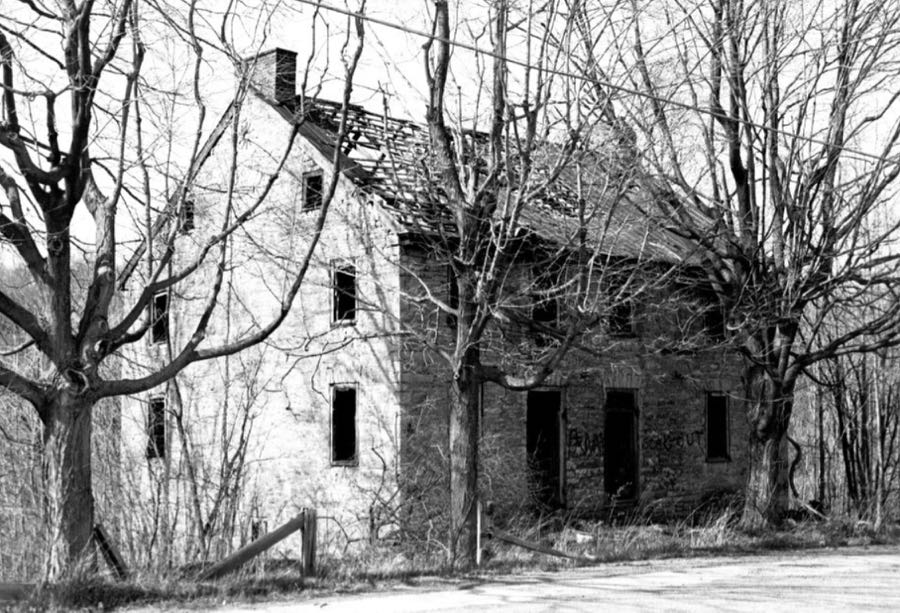 Nailing down the location of the tavern ruins had required a lot of effort, but I’d finally been able to spot them, barely, in a Google Maps street view. When I arrived at the exact spot, however, some villain had absconded with said ruins. Sadly, there is no longer any sign that the Stone House tavern ever existed.  Undaunted, I continued on, past Cumberland and into Frostburg, where my tour officially started. I was following Trip 6 from Dale Coyner’s excellent Motorcycle Journeys Through the Appalachians, which is a must-have resource for anyone interested in touring these mountains. Dale has an uncanny ability to find the most entertaining and scenic roads in any part of the country, and this route was no exception. I saw sights like this one all day long:  My 2013 335i doesn’t have any autonomous driving features, but I could swear that approaching corners like the one above, the car would accelerate all on its own and hurl itself into the turn with abandon. In practically no time, I arrived in Frostburg—just as the snow flurries ended. Back in 1855 when the Hocking House was built, it was well outside of Frostburg. Now it’s nearly in the middle, thanks to the town’s expansion. It served various families over the years and is said to have been an important stop on the Underground Railroad, sheltering African American slaves who were escaping to their freedom in the north. For such noble service, this house deserved a better reward than to become a lodge of the Royal Order of the Moose (1942) or, more recently, a boarding house for Frostburg State University students—but that’s what happened.  Frostburg has many beautiful houses, with this elaborate frame dwelling being my favorite.  The more-or-less simultaneous development of coal mines, coke ovens, and railroads in this area brought great prosperity to Frostburg. The first superintendent of the Borden Coal Mining Company was Albert C. Greene, who lived in this Italianate-styled house from about 1850-1882. Against all odds, the Borden Company appears to still be in business.  The Case of the Missing Bridge… Jesse Tomlinson’s Inn was one of the first taverns along the National Road, having opened for business in about 1816 (shortly after the road reached this area). Notable guests included Albert Gallatin, who, as the longest-serving Secretary of the Treasury, was an outspoken advocate for a national road, and two Presidents-Elect: William Henry Harrison (who died of pneumonia after only 31 days in office as the 9th President), and James K. Polk, who stopped here in 1845 on the way to his inauguration as the 11th President of the United States.  This inn is one of the largest such structures along the National Road. Note the very wide chimneys at each end, with their unusual, semi-circular tops. It remained in business through the 1800s and then became a private residence. As best I can tell, it has been vacant for some time now. (Postcard from 1908 courtesy of Frank Busca’s excellent Route40.net website.)   I admired this weathered barn adjacent to the Tomlinson Inn, and the little meadow to the right. Back home, I learned that the area is actually called the “Little Meadow.” In 1754, George Washington and about 160 Virginia militiamen camped here. For more than a decade, tensions had been building between Britain and France, with both claiming ownership of the Ohio Territory. Washington’s forces were charged with widening Nemacolin’s Trail so that wagons could pass and supporting Captain William Trent, whose men were attempting to build a fort near what is now Pittsburgh. Once again, a seemingly ordinary spot in the Mid-Atlantic area turns out to have experienced something of historical significance. 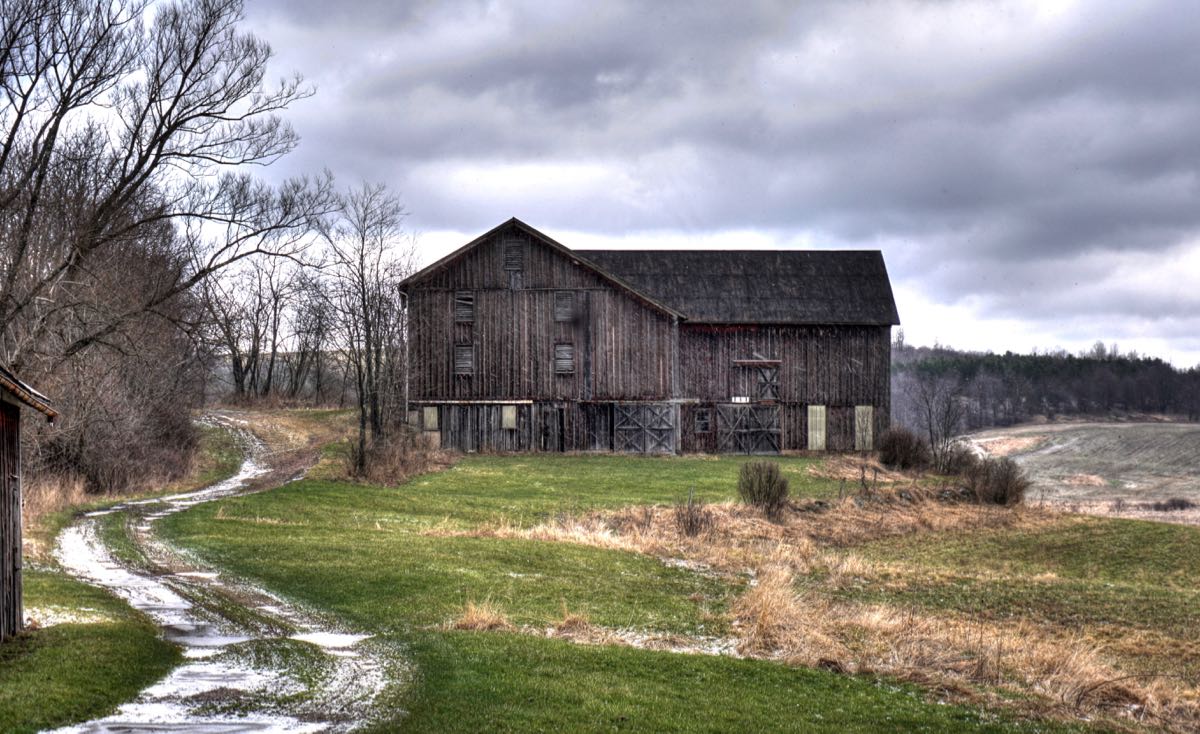 Continuing on, I crossed the Casselman River at the “Little Crossing,” as it was known by travellers on the National Road who forded the stream here. Next up was the Mason-Dixon Line, where I left Maryland and entered Pennsylvania. A mile later, I arrived at the Wable-Augustine Tavern, built in 1820 by John Wable. Only a few frame taverns have survived to the present, and this one remains in excellent condition. It operated during the heyday of the National Road (1820-1855), before railroads were built. Since then, it has been a private residence.  The National Road was a turnpike, with tolls that varied by vehicle size and/or the number of cattle being driven. The highest tolls (about 12 cents) were charged to stagecoaches and “phaetons or chaises with two horses and four wheels”—the 1800s’ version of a luxury sports convertible. Only three of the original tollhouses have survived, including this one in Addison, PA. It has been lovingly restored by the Daughters of the American Revolution and is now a museum. 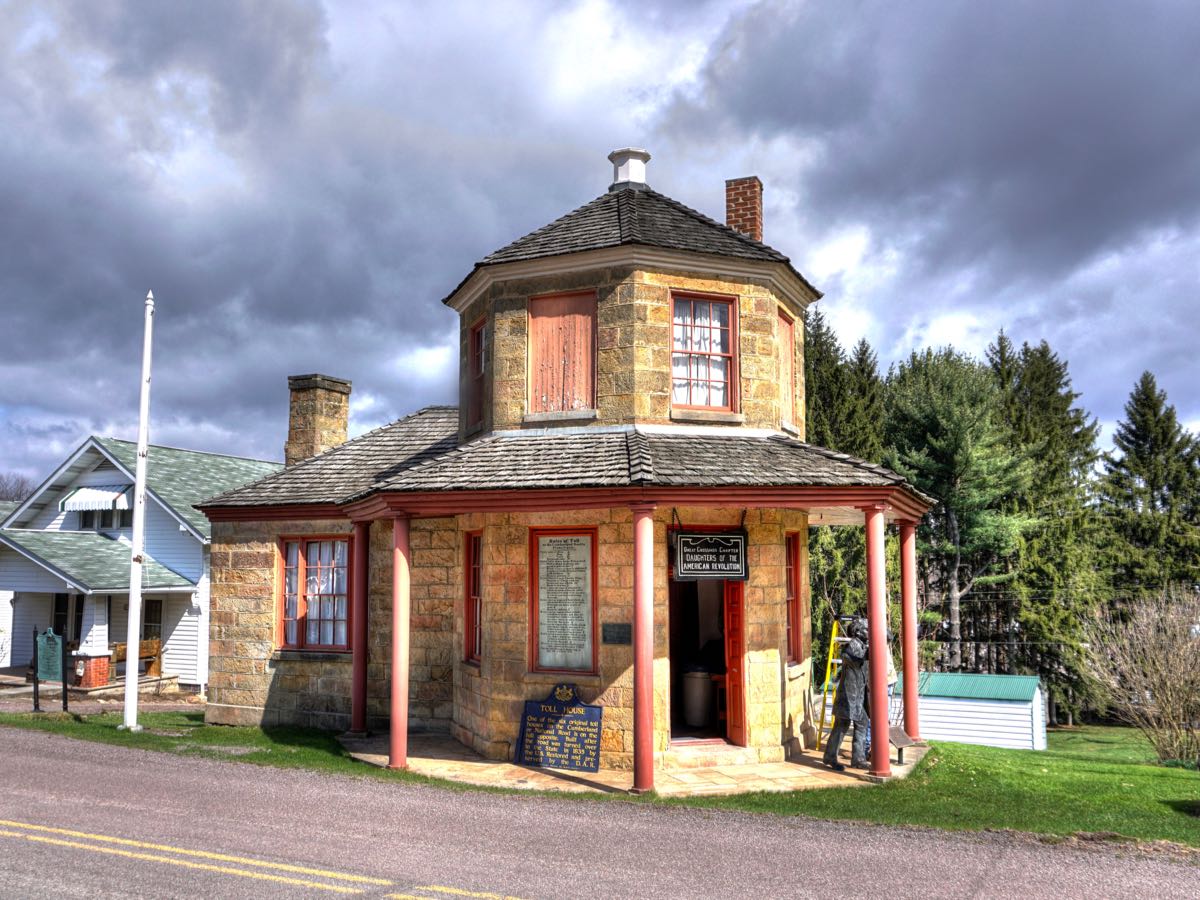 The tollhouse was a charming place, and very much in keeping with today’s “tiny house” trend. I’ve seen quite a few hexagonal and octagonal houses during my various travels—but this was the first time I’d ever encountered a seven-sided one!  Remember Little Crossing? Well, next up was Great Crossings, where early travellers had to ford the mighty Youghiogheny River. With the construction of the National Road, a sturdy sandstone bridge was built over the river in 1818 at the little town of Somerfield, eliminating one of the most difficult challenges along the route. 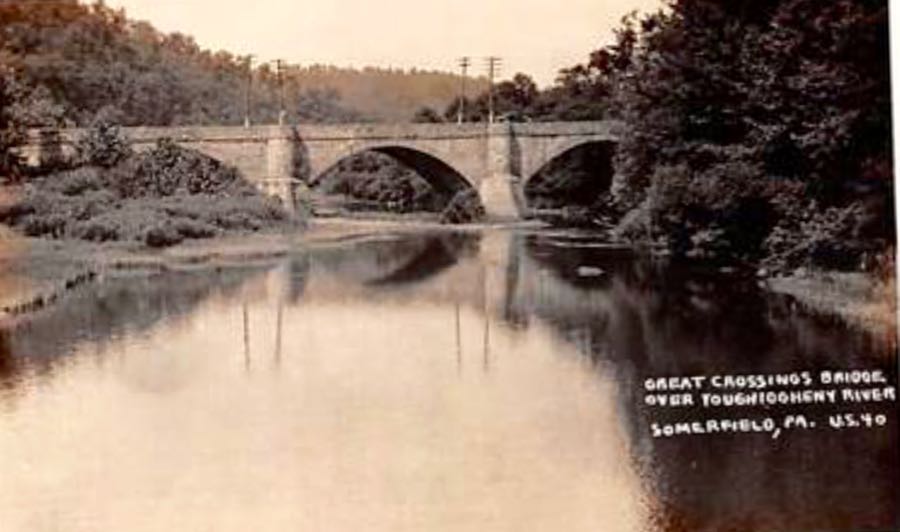 Everything was fine until the Great Flood of 1936. Although the Great Crossings Bridge was not significantly damaged, almost every other place and structure along the Youghiogheny was—and the Army Corps of Engineers stepped in and decided that a major flood control project was warranted. By the time they finished in 1943, the bridge and the entire town of Somerfield were under the roughly 880 million gallons of water of the new Youghiogheny River Lake. Of course, the Corps of Engineers also built a new bridge over the lake at Great Crossings. In this photo, I’ve approached the lake on the boat launch—except it’s really the original National Road, before they flooded the area. That road continues right along, under the lake and across the old sandstone bridge. (In the background is the “new” 1943 bridge, but what fun is that?)  Every so often when there is a severe drought, the lake’s water level drops sufficiently to expose the original bridge. As shown in this Mapio photo, the 1818 bridge is still in pretty good shape. On the day of my visit, the water level was normal, so no sign of “what lies beneath.” For those of you who, like me, are fascinated by this question, check out this Google Maps satellite view, which was taken at a low water level. Although the Corps of Engineers razed the town before flooding it, there are still plenty of foundations down there, in addition to the old bridge.  …and the Case of Another Missing Tavern At least the old bridge is still there, even if buried under 50 feet of water. When I arrived at where the historic Rush House should have been in Farmington, PA, I found nothing—the old tavern had been demolished earlier this year. (Rush House photo from the 1930s courtesy of Syvilla (Younkin) Rush website. 2018 photo courtesy of the Uniontown Herald-Standard.)   I was deeply disappointed, since I hate to see such places torn down—and, moreover, I wanted to get a photo of the Rush House for my friend Neil (yes, that Neil). The tavern was built in 1837 and soon acquired by Sebastian “Boss” Rush, a self-made man who rose from a constable who was too poor to own a horse, to a popular and much-admired tavern owner.  Rush House served as a stagecoach stop until 1852, when the advent of railroads eliminated the need for stages. It continued as a hotel for another 100 years, closing only following the death of Boss Rush’s granddaughter, Sallie Rush, at age 94. During its long operation, the Rush House hosted at least three Presidents, along with Sam Houston, Henry Clay, P.T. Barnum, and the “Swedish Nightingale,” soprano Jenny Lind. The unfortunate disappearance of this historic tavern serves as a reminder: Go see those old places before some malefactor decides they’re in the way and destroys them. The Half King and the Half Brother: George Washington’s Only Surrender So back to George Washington, whom we last saw when he and his militia were camping at the Little Meadow in 1754. They continued on, fording the Casselman River at Little Crossing and the Youghiogheny at Great Crossings, on their way to meet Capt. Trent at the forks of the Ohio River. Long before this destination, however, they learned that a sizable French expedition had forced Captain Trent to give up his efforts to build a fort and were, themselves, building Fort Duquesne. Washington stopped at what was known as Great Meadows—the only large open field in the vicinity—and built a very rudimentary stockade, which he named Fort Necessity. If the French were to attack, he wanted to be able to meet them in the open. The fort was tiny, barely 50 feet in diameter, with several shallow trenches around the outside where they mounted nine small “swivel gun” cannon. Today there is a national park here, with a reconstruction of Fort Necessity and a visitor center.    Washington was joined at Fort Necessity by Tanacharison, the “Half King” leader of a group of Mingo Indians sympathetic to Britain. Meanwhile, the French had ordered Ensign Joseph Coulon de Villiers de Jumonville to lead a small force of 35 to intercept Washington’s militia and order them to leave the Ohio Territory. Washington sent 75 of his men to find the French soldiers—but they traveled in the wrong direction. Tanacharison discovered the actual location of the French, and together with Washington and about 50 of their men they decided to stage a surprise attack early on the morning of May 27, 1754. (Painting courtesy of Mount Vernon.)  Accounts vary, but it is clear that Washington’s men fired on the French, killing about a dozen of them and wounding de Jumonville. The French officer managed to call for a ceasefire and attempted to read the summons ordering the British from the territory. Partway through, according to several sources, Tanacharison leapt toward de Jumonville, killed him with his tomahawk, and scalped him. At the same time, the other Mingos killed and scalped the other wounded French soldiers, with the rest surrendering to Washington. The massacre took only 15 minutes in total, after which Washington returned to Fort Necessity with the prisoners. Approximately 1 month later, a force of 600 French and Canadian soldiers, plus another 100 Native Americans, arrived at Fort Necessity. They were led by Louis Coulon de Villiers—the older half-brother of de Jumonville. Along the way, they encountered the site of the de Jumonville massacre, finding a number of scalped corpses (presumably including de Villiers’ brother). As the French approached Fort Necessity, Washington arrayed his men to fight in the traditional British “open field” manner of battle. The French forces, however, stayed within the surrounding forest and fired their muskets from there. Washington’s soldiers had to retreat to the fort and the surrounding trenches, which were now filled with water from heavy rains. Moreover, their swivel guns could not be fired due to the rain. Under a ceasefire, de Villiers offered Washington the opportunity to surrender and return to Virginia. Given the circumstances, he accepted this offer—the only time he surrendered during his military career. The battles of Jumonville Glen and Fort Necessity sparked the start of the French and Indian War and, more broadly, the worldwide Seven Years War between Britain and France. (Robert Griffing painting of British retreat courtesy of Explore PA History.)  A year later, General Edward Braddock led a large force of British and Colonial soldiers along the expanded Nemacolin Trail to Fort Duquesne, accompanied by George Washington. The attack on the French failed miserably, however, with two-thirds of Braddock’s troops killed or captured and Braddock himself being severely wounded. He died during their retreat and was buried beneath the road to prevent the French or Indians from discovering and desecrating his remains.  Eventually the British won the French and Indian War, with the result that Britain gained control of all the French possessions in North America east of the Mississippi River. In 1804, road workers discovered General Braddock’s remains and reburied them on a nearby hill. Today a monument marks Braddock’s final resting place.  BMW Sets New Record for Summit Mountain Hill Climb! In preparing for this tour, I was surprised to learn that automobile hill climb competitions were held just west of Fort Necessity during 1913 through 1915. The first race was up the eastern side of Summit Mountain, while the other two climbed the western side. I resolved to visit these sites and learn more about the competitions. First, however, I detoured a couple of miles to find the Wharton Furnace. It began operations in 1837 but closed by 1850. At the start of the Civil War, it was recommissioned, converted to a “hot blast” furnace, and used to produce cannonballs for the Union Army. After the war, the furnace closed once again, primarily because there was no water or rail transportation to ship its iron to Pittsburgh or other destinations.   Back on the National Road, I scouted the locations of the Summit Mountain Hill Climbs. This is the western side of the mountain, with Uniontown and Hopwood in the distance. The course used in 1914 and 1915 on this side of the mountain was 3.5 miles in length.  At the top of the mountain is the Summit Inn, where I’ve stayed on a couple of occasions (see, for example, From Summit Inn to Summit Point).  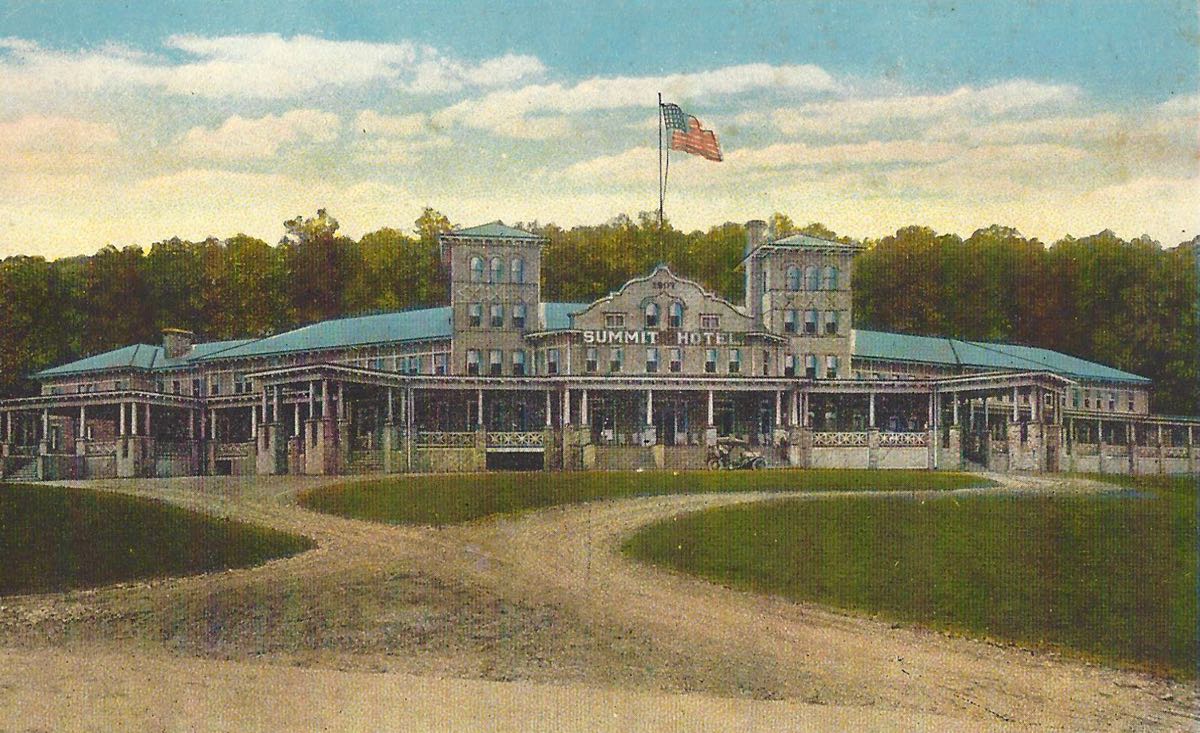 During the early years of the fledgling U.S. auto industry, hill climbs were a popular way of testing the speed, handling, and durability of American and European cars. The Fayette County Automobile Club organized the Summit Mountain Hill Climbs in conjunction with Uniontown’s “Old Home Week” festivities. The 1913 races covered 1.1 miles from the base of the eastern side of the mountain to the Summit Inn at the top. (Unless otherwise indicated, historical racing photos are courtesy of Marci Lynn McGuinness’ very enjoyable book Yesteryear at the Uniontown Speedway.)  Cars were classified according to their cost when new, e.g., less than $1,000, from $1,000 to $1,600, etc. There was also a “Free-for-All” event for any and all entrants, which was won by Ed Riffle in a Packard. Other entries included Fords, Buicks, and Pope-Hartfords, with the fastest official time of the day going to Howell McCormick in a Packard with a time of 1 minute 55 seconds, for an average speed of 34.4 mph. A local car dealer managed an exhibition run in a Stoddard-Dayton at 1 minute, 49 seconds, for an average of 36.3 mph.  The 1913 Summit Mountain Hill Climb was a huge success, and similar races were held during the next 2 years. The west course started at the Barnes Mansion in Hopwood, climbing the 3.5 miles to finish again at the Summit Inn. This run incorporated the notorious “Turkey Nest” S-curves, where many a competitor ended up running into the mountainside or, even worse, driving off the mountain on the other side of the road.  At the 1915 hill climb, Ralph DePalma and his Mercedes were famously beaten by local hero Charlie Johnson in a Packard. DePalma was fresh off his victory at the 1915 Indianapolis 500, and all of Pennsylvania celebrated Charlie’s major upset. Over 25,000 spectators watched the event, with crowd control becoming a major issue. Moreover, there were a number of driver and spectator deaths and injuries during 1914-1915. (DePalma photo courtesy of eMercedesBenz.)  The 1916 hill climb was all set to go when the Pennsylvania State Highway Department abruptly outlawed racing on Summit Mountain. Charlie Johnson and other racing enthusiasts promptly raised funds and built a 1.125-mile board racing track in Hopwood, which flourished from its opening in late 1916 through June 1922. The track was situated here, with the grandstands on the left (south) side, and turns 1 and 2 of the oval in the immediate foreground. The area is now used for a golf driving range. (Sacrilege!)  With a smooth surface, wide-radius turns, and 34-degree banking, speeds at the Uniontown Speedway were way up, with DePalma turning a lap at 105 mph in the 1916 race. Board track racing was notoriously dangerous, however, and 5 racers and 2 spectators were killed at the opening event alone.  Ralph DePalma wasn’t the only big name at the new speedway, having been joined by the likes of Louis and Gaston Chevrolet, Jimmy Murphy, Barney Oldfield, 2-time Indy 500 winner Tommy Milton, and pretty much all the best racers of the time. Cars included Duesenbergs, Mercedes, Hudsons, Frontenacs, Millers—and Barney Oldfield’s extraordinary “Golden Submarine,” which was one of the earliest attempts at using aerodynamics and incorporating a “safety cell” in automobile racing. The Sub was enormously successful, too, winning 20 of the 54 races it ran, although the idea of enclosed cockpits didn’t catch on. (Golden Submarine photo courtesy of Bang Shift.)  Oldfield himself was quite a character. He’s pictured here in his “Blitzen (Lightning) Benz,” which suggests the level of bravery required just to drive one of these monsters—let alone race them against 30 other crazed speed freaks. In 1910, he drove this car at 131 mph on the beach at Daytona, Florida. As BangShift.com notes, this was “a figure that stunned a public that thought it would be impossible to breathe driving an open car faster than 60 mph.” (Photos courtesy of the The First Super Speedway.)  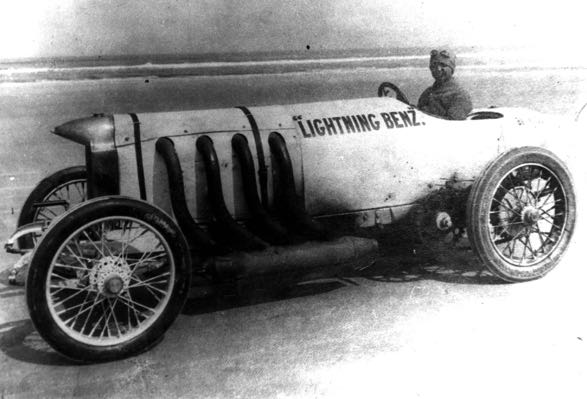 Here, on the right, is Louis Chevrolet at the wheel of his Frontenac Special at Uniontown Speedway in 1918. Louis was born in Switzerland and began his racing career with Fiat in 1905. He cofounded the Chevrolet Motor Car Company in 1911 with William Durant but left a few years later to start the Frontenac Motor Corporation with his brothers Gaston and Arthur. In the photo (courtesy of Indiana Memory, note that after 2 years of use the surface of the board track is still in good shape. Soon, however, there were actual holes in the wood that drivers had to dodge. One was large enough that a rather brave/foolish young fellow would stick his head through it from below and watch the cars approaching…  By mid-1922, the Uniontown Speedway needed major repairs, there were disputes with the landowner, the Uniontown Speedway Association declared bankruptcy, and the track closed for good. Rumor had it that Charlie Johnson absconded to Cuba with the proceeds from the final race, but author Marci McGuinnes disputes this story. Either way, the hill climbs and speedway brought more drama and excitement to Uniontown during 1913-1922 than have happened in all the years since. The fastest time of 1 minute 49 seconds, for the 1913 hill climb on the 1.1-mile eastern section of the National Road, has stood unchallenged for 105 years. Of course, anyone driving up the hill today at the posted speed limit of 45 mph would easily break this record, with a time of 1:28.00, and I’m sure that happens many times every day. But where’s the sport in that? I measured 1.1 miles down the hill from the Summit Inn, turned around, and from a standing start allegedly got to the top in 45.34 seconds. The time is alleged, of course, since if I somehow actually managed to achieve this time, it might have involved going a bit over the speed limit, which I’m sure I wouldn’t have done. Nonetheless, until otherwise challenged, I will brazenly claim the new Summit Hill Climb record for the 1913 course! A Downtown, and a Murderous Scandal Downtown Uniontown has more to offer than just forgotten racetracks. The beautiful Fayette County Courthouse has presided over various legal matters since 1892. It is the third courthouse to occupy this spot and is built of gray sandstone in the Richardsonian Romanesque style—which I’ll admit is one I hadn’t heard of before.  My favorite building in Uniontown was the 1901 First National Bank, built by J.V. Thompson and J.D. Ruby with a dome and rounded front corner. Josiah Van Kirk Thompson was a banker and real estate investor who amassed great wealth buying and selling coal lands in Pennsylvania. Like many other millionaires, however, he died penniless as a result of the Great Depression.  In marked contrast to the courthouse and bank building, the Old West Schoolhouse is downright primitive. It was built in the late 1700s and bought in the early 1800s by Amos and Margaret West—who promptly disassembled the log home, only to reassemble it in 1816 for use as a school. In 1939 it was given to the local Girl Scouts organization, which oversaw its renovation. Today, somehow, it is a hair salon.  On the outskirts of town is this 2˝-story brick house from 1890—and a BMW 335i that is showing the effects of the earlier snowfall. Naturally I had washed the car before starting out on this trip. Inevitably, it got dirty almost immediately!  Adam Clarke Nutt was a Captain in the Union Army during the Civil War. Subsequently, he studied law and was soon very successful as a banker, eventually becoming the Cashier of the Pennsylvania Commonwealth Treasury in 1881. He built this Victorian Queen Anne mansion in 1882, on a hill overlooking Uniontown. The wraparound porch and stone walls were added in 1912; otherwise the house’s appearance has not changed since its construction.  Sadly, fate did not smile on Capt. Nutt. In 1882, his 22-year-old daughter Lizzie became engaged to a local lawyer named Nicholas Dukes, who was about 10 years older. Dukes had been engaged twice before and, within a few months, he decided to break off his engagement with Lizzie. (Drawings of Nicholas Dukes and Lizzie Nutt courtesy of Murder By Gaslight.)   Taking a position of moral superiority, Dukes wrote a lengthy letter to Capt. Nutt, breaking the engagement and attempting to justify his action by calling Lizzie’s “purity” into question. Among a great many other things, Dukes wrote the following: She came up and placed herself on my lap, as usual, and after fondling her for some time I made a solicitation. To my infinite astonishment and grief she melted down like wax. Oh how I pitied her weakness. But where is there a man that could resist the temptation of such beauty and loveliness. You would have done as I did. But what was my horror and heartsickness when I found the signs of her virginity wanting.Lizzie denied every word of the letter, as did two men named by Dukes as having previously had relationships with her. Capt. Nutt was outraged and (after further letters) stormed to Dukes’ room at the Jennings Hotel. A fight ensued between the two men, ending only when Dukes shot Nutt with a 32-calibre pistol, killing him outright.  Capt. Nutt had been widely admired and respected in Uniontown, and Dukes instantly became the object of hatred by the entire population. At his trial, however, the jury found him not guilty on the grounds that he was defending himself. The city was outraged, and Dukes had to go into hiding to avoid being lynched. He was formally condemned and soon disbarred from practicing law. Then, 6 months later, Lizzie’s brother, James Nutt, approached Dukes on the street outside the hotel and shot him five times. (Drawing courtesy of Andrew Porwancher’s engrossing book The Devil Himself.)  James Nutt was arrested for murder and tried in Pittsburgh, given that Uniontown was universally on his side. Even with the change in venue, the crowds attending the trial heaped bouquets of flowers on the defendant’s table. The entire nation was captivated by the story and cheered when the jury found Nutt not guilty by reason of insanity. Uniontown gave him a hero’s welcome when he returned from Pittsburgh. There were two subsequent twists of fate: First, 2 years later James Nutt shot 2 men in Kansas, was arrested, tried the insanity defense again, but was found guilty. He served out a lengthy prison sentence. And second, the expression to act “nutty” came into popular use during this period.  The Road Less Traveled (and Mind the Ovens) At Uniontown, the National Road departs from the old Nemacolin-Washington-Braddock Road and heads west to Illinois, while the latter travels northwest to Pittsburgh. I initially followed the old Braddock Road—more or less, since most of the original route has disappeared. I was looking for the lost industry that had made Uniontown so prosperous. First up was another result of that prosperity, namely the John S. Douglas house from 1901. Douglas started out as a traveling salesman for farm equipment but opened a real estate office in Uniontown at the start of its building boom. The mansion has served as a funeral home since the 1980s. (And, just in case you were wondering, it’s another example of the Richardsonian Romanesque style.)   My last stop in Uniontown was at the imposing Gallatin School, which was built in 1908 and named for former Treasury Secretary Albert Gallatin. Although the building is actually just two stories, it looks much taller as a result of the ornate terra cotta portico and columns. It served as an elementary school until closing in the early 1980s. The Gallatin School is now a homeless shelter for transitional and long-term residents.  As the coal and steel industries blossomed in western Pennsylvania, Fayette County became a major producer of coke—a high-carbon fuel with few impurities, produced by heating coal to high temperatures. It was used to smelt pig iron from iron ore, with the pig iron subsequently processed into steel. The production of coke, however, released numerous dangerous contaminants into the air and water. Coke was generally made in brick ovens, which would be built side by side in rows that sometimes extended more than a mile.  Since western Pennsylvania is littered with old coke ovens, I decided to see if I could find any of them. With only vague guidance to go by, I ended up on this narrow, muddy lane in the exact middle of nowhere. I was almost positive that the Stambaugh Coke Ovens were close by, but even after walking a half-mile down the path, I couldn’t see any sign of them.  Eventually, I saw a large stone pyramid sitting on top of the earthen bank to my right. I clambered up for a closer look—and almost stepped into the top of one of the coke ovens! I’d been walking parallel to them without realizing they were on the other side of the bank. And there was another entire row on the other side of the little stream, as well.  I didn’t count how many of the old ovens were here, but they extended as far as I could see. Coke production began to decline in the late 1920s but rebounded during World War II as demand for steel skyrocketed. Health concerns largely shut down the remaining facilities by the 1950s, and coke was produced using “byproduct” and “recovery” ovens that safely handled the sulfur, gases, and other noxious materials that were heated out of coal.  From Quarry to a Haven for Explosive Welding Not too far from the Stambaugh Ovens, I found the magnificent Isaac Meason House. It took 5 years to build, being completed in 1802, and is one of only two surviving houses in the U.S. made entirely of dressed stone with a full Palladian design. There are seven elements to this style: the central 2˝ story main house, flanked by two “hyphens” that connect to 1-story wings on either side. The final elements are the two unattached “dependencies” on the north and south ends. Meason was the richest person in Fayette County, having accumulated his wealth by—no surprise—the iron industry in the late 1700s. His Union Mines 1 and 2 were built alongside Dunbar Creek in the 1790s and were the first viable iron furnaces in the area.    I continued on in the general direction of Ohiopyle, following Dunbar Creek, and was startled to see this unusual structure by the side of the road. At first I thought it had been a building, but the more I looked at it, the less likely that possibility seemed. Moreover, I noticed other ruins higher up the mountainside.  Back home, I learned that this had been the location of a mammoth quarry for Loyalhanna limestone (more commonly known as bluestone). The structure by the roadside had been the foundation for a gigantic limestone tipple, which is visible in the center of the first photo below. (Historic photos courtesy of Jay on Flickr and Interesting Pennsylvania and Beyond.)  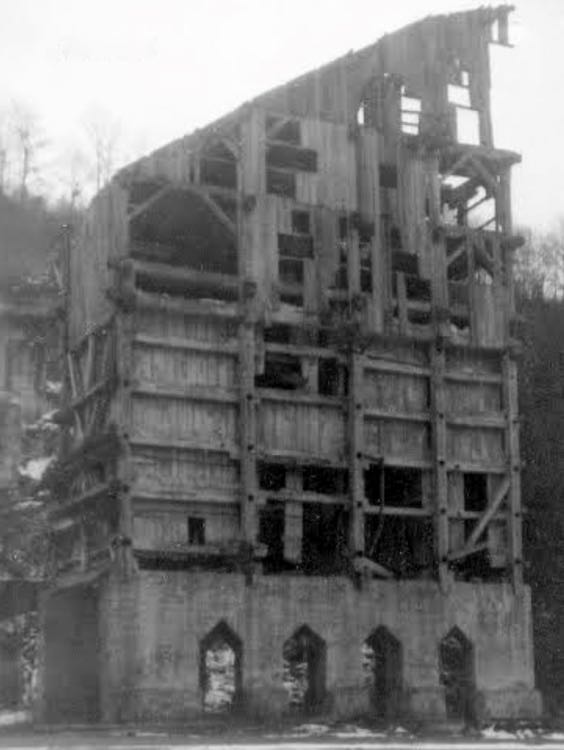 The Bluestone Quarry produced upwards of 900,000 “Belgian blocks” annually, for use in building roads, as well as mountains of crushed limestone for railroad beds and other purposes. The original paved streets of Pittsburgh, for example, were made using blocks from this quarry. Eventually the quarry operation literally went underground, resulting in the Dunbar Mine with miles of passages inside the mountain and several very large chambers. By the late 1940s, however, the quarry and mine had shut down. In 1965, the DuPont Company decided the Dunbar mine would make the perfect place to implement its newly developed “explosive welding” technique. The idea first came about during World War I, when people noticed that pieces of shrapnel didn’t merely imbed themselves into armor plating but were actually welded to it as a result of the force of the impact. DuPont used explosive force to join large sections of dissimilar materials (e.g., cladding regular steel with stainless steel or joining steel and aluminum) and for producing industrial diamonds. And what better place to routinely set off major explosions than an empty mine, lined by enormously strong limestone, and having a series of passages to act as a muffler? Dynamic Materials Corporation bought DuPont’s operation in 1996 and has continued explosive welding at the Dunbar Mine. (Diagram courtesy of Quora.com.  Back in the impatient 335i, I’d barely driven a hundred yards before I spotted another of the odd walls, hiding behind some trees directly on the banks of Dunbar Creek.  These ruins, too, were once part of the Bluestone Quarry operations. I’m guessing that the creek powered machinery to cut and shape the limestone slabs quarried out of the mountain. A series of floods destroyed the mill by the 1920s. For a brief period in the early1970s, the creek-side foundations were repurposed into the “Dunbar Rippling Waters Drive In” restaurant—but I suspect Hurricane Agnes in 1972 put an end to that endeavor.   Waterfalls, Big and Bigger The road from Dunbar to Ohiopyle was one of those unexpected joys: turn after turn in rapid progression, elevation changes, smooth pavement, minimal traffic, and great scenery. While the 335i is perfectly content to chew up Interstate miles when necessary, it really comes alive on back roads like these, cornering on rails and putting its prodigious power to good use. Driving pleasure is becoming harder and harder to experience on the crumbling and overcrowded roads in much of the U.S., but places like this remind you of just how much fun it can be. 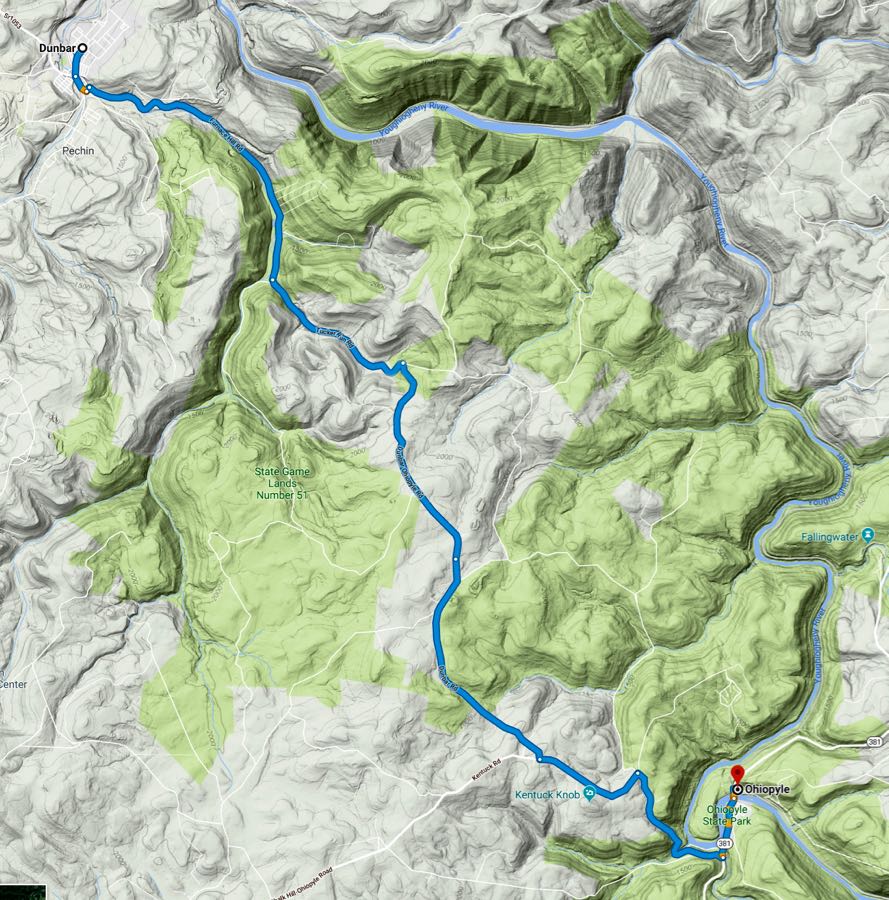 Near Ohiopyle, suppose you were happily wading along in the waters of Cucumber Run and suddenly came to a view like this one:  Yes, that is indeed the top of a waterfall—and it’s one of the prettiest I’ve seen. The falls are about 30 feet high, with the stream joining the Youghiogheny River only 500 feet farther on.  The trail along Cucumber Run got progressively rougher and more difficult as I went on, but it sure was scenic.  On my way back, I realized that you could leave the trail and make a beeline for the falls themselves. 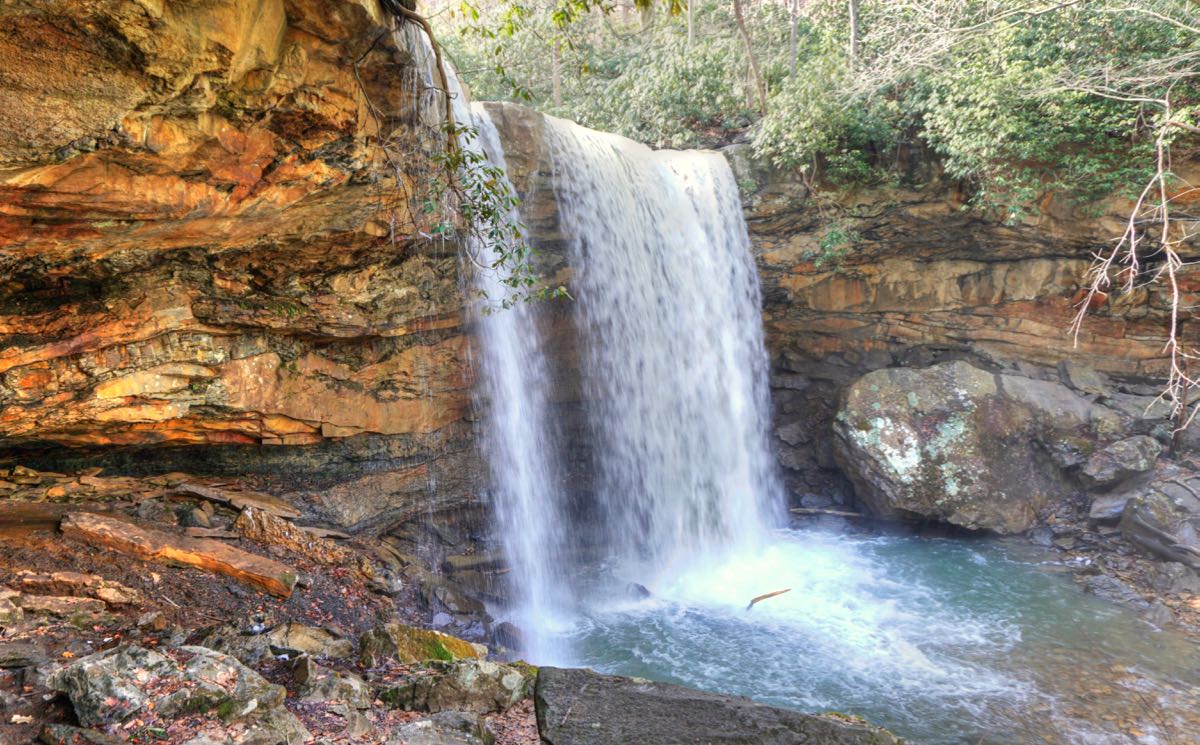 Best of all, you could actually go behind the waterfall—with your reward being a beautiful rainbow downstream.  From Cucumber Falls, it was only a short hop into Ohiopyle, one of my favorite spots in Pennsylvania.  The original Ohiopyle Low Bridge carried the Western Maryland Railroad across the Youghiogheny River from 1912-1975. After sitting unused for many years, it was incorporated into the Great Allegheny Passage rail trail. The current pedestrian bridge was built on the original piers in 1999.  My father used to canoe down the Youghiogheny River—not raft, not kayak, but canoe. He had a very great respect for the river, as everyone should. I’ve lost track of the number of boating deaths on the Yough, but it’s a sobering figure. This is one of the milder sections, above the falls.  And these are the Youghiogheny Falls, dropping almost 20 feet vertically across a width of about 200 feet. With the high water levels on the day of my visit, the vertical drop is completely obscured by the torrent of water flowing downstream. To get a better idea of the scope of this waterfall, I’ve added WWKayaker’s excellent multi-image photograph below. (Kayakers are allowed to run the falls only when the water levels are low.)   Covered Bridges, Curving Roads, and Climbing Nonsense At Ohiopyle, I reconnected with the RoadRunner Magazine route, and the series of outstanding driving roads continued on and on. Outside of town, I drove by Frank Lloyd Wright’s masterpiece, Fallingwater. It was too late in the day to visit (for what would have been the fifth time). If you’ve never been there, add it to your must-see list. On the way to Cucumber Falls, I’d also gone by Wright’s lesser-known Kentuck Knob. One of these days, I’ll get there in time to take the tour. Elsewhere, the road routinely offered views like this:  And this scene, too, of the Barronvale Covered Bridge crossing Laurel Hill Creek. It was built in 1830, 1847, or 1902, depending on whom you ask. Apparently the Somerset County bridge records are a bit thin.    A mile downstream you’ll find King’s Covered Bridge, which was built sometime between 1802 and 1845. After Scullton Road bypassed the old bridge, it was used as a barn for livestock by the King family until 2002.  Although I was running far behind schedule—a consequence of so many photo stops, rather than any lack of speed on the part of the 335i—I still had to take advantage of more scenic areas. They were pretty much everywhere you looked.   The town of Confluence, PA is so-named because Laurel Hill Creek joins the Casselman River here (on the left), with both flowing into the Youghiogheny (on the right). With all the prior rain, it’s a wonder that the town wasn’t completely underwater. Note the trees standing in the water (not to mention the nervous expression on the BMW).   Your modern, well-equipped hunting lodge in this part of Pennsylvania features a wood-burning stove—and satellite TV.  By now it was after 7:00 PM, I was cold and tired, and I was still hours away from home. But I was looking for Mount Davis, the highest spot in the state. At 3,213 feet, Pennsylvania’s apex towers over those of its neighbors Ohio, Delaware, and New Jersey, but it falls well short of Maryland, New York, and West Virginia. As I hiked up to the summit, I discovered this tall observation tower.  Now, there was no way that I had enough energy left to climb this stupid tower, just to get a photo of a bunch of treetops. And I knew that, up above the trees, the cold wind would be fierce. Besides, at my age I have to worry about excessive levels of exertion. So I climbed up anyway, with the voice in my 17-year-old brain urging me on. The view was pretty nice, as it turned out. I believe that’s the town of Salisbury in the distance, about 6 miles away.  At least going down was a lot easier!  Back in the faithful 335i, I turned the heat up and unleashed the car down the mountain. I stopped at this Amish farm outside of Springs, PA for a reminder that today’s life for some people is not so very different from their ancestors’ 200 years ago. The old buggy may look like a museum display, but I expect it’s still used almost every day.  With a final picture before the light disappeared, it was time to reel off the last 162 miles back to Catonsville.  Despite the cold temperatures, it was a hugely enjoyable day of touring—full of history, driving fun, hidden treasures, and old racing records just waiting to be broken. Rick F. PS: Unless noted otherwise, historical photos are courtesy of the Library of Congress, the National Register of Historic Places, or Wikipedia. Last edited by Rick F.; 05-04-2018 at 09:36 AM.. |
| 05-03-2018, 10:32 AM | #3 |
|
Down Under!!

1621
Rep 4,294
Posts |
Rick, glad to see another trip mate, enjoyed this one very much, and apart from probably being one of those foolish kids that would have stuck my head out between those wooden plank raceways (similar events watching the Speedway in Brisbane in early 1980's) this trip once more makes me wish that i could move my family to some of those parts. (though my wife would probably kill me as she loves the hustle and bustle.. me not so much)
The grand white family house easily being my favourite of the ones that you showed on your trip too. I have to say that the first 2 pictures of your waterfalls blew me away, beautiful.  I enjoyed reading about great crossing and about what lies beneath.  lol, yeah i did quickly check out the foundations on google maps and its a marvel of engineering that the original bride still stands, even after being submerged pretty much for such a long long time. lol, yeah i did quickly check out the foundations on google maps and its a marvel of engineering that the original bride still stands, even after being submerged pretty much for such a long long time.They don't build em like that anymore. Also can't believe you hiked up that fire spotting tower.  Good show mate Good show mate  Appreciate the shotgun ride through the ages your semi local parts of the US. Looking forwards to your next outing Rick, Until then mate, stay safe and have fun  edit: btw Rick, I LOVE old woodwork interior roof shots of barns/homes and covered bridges, the engineering and design fascinates me, so thanks for the internal shots of the Barronvale covered bridge.
__________________
2007 EuroSpec Z4///MC - Building/Developing Z4 GT3
Powered by  Last edited by Vanne; 05-03-2018 at 10:38 AM.. |
|
Appreciate
0
|
| 05-03-2018, 11:24 AM | #4 | |
|
Lieutenant Colonel
 946
Rep 1,910
Posts |
Quote:
My pleasure, I'm glad you enjoyed it! As a kid, I thought it would be fun to be an architect, but ultimately I went in a different direction. But I still love a good mansion or courthouse! Even better if it's haunted or has a secret passage. Once, I found a place that had both.  Rick |
|
|
Appreciate
0
|
| 05-03-2018, 11:33 AM | #5 | |
|
Lieutenant Colonel
 946
Rep 1,910
Posts |
Quote:
Excellent! As for sticking one's head through a hole in a racetrack to watch the cars approach, I can't say that I ever did that. But I remember being at the Marlboro 12-hour endurance race back in the mid-1960s and sneaking behind a plywood wall to take a shortcut down to the hairpin turn. My buddy and I could hear the cars roaring by on the immediate other side of the plywood, and he helpfully mentioned that "This is where the two Pontiacs crashed and broke through the fence at last year's race…" It's a wonder that any of us ever survive to adulthood! I'll keep an eye out for more interior details for you in the future. All the best, Rick |
|
|
Appreciate
0
|
| 05-07-2018, 10:48 AM | #6 |
|
dances with roads
4717
Rep 4,094
Posts |
More roads I need to discover! Thanks so much for sharing the story.
I've been to Kentuck Knob. It's not Fallingwater, but it's an interesting place with an interesting story. Don't eat too much the night before you visit or you may not be able to make it into the master bedroom... |
|
Appreciate
0
|
| 05-08-2018, 02:48 PM | #8 | |
|
Lieutenant Colonel
 946
Rep 1,910
Posts |
Quote:
Lotsa great roads out there, for sure! I'll get to Kentuck Knob one of these times, hopefully soon. I remember at Fallingwater how narrow and short the doorways were--so that, once you stepped into the room, it would feel large by comparison. Wright also used windows that wrapped around corners, for the same reason. Clever guy. Glad you enjoyed the report! Rick |
|
|
Appreciate
0
|
| 05-08-2018, 02:53 PM | #9 | |
|
Lieutenant Colonel
 946
Rep 1,910
Posts |
Quote:
Thanks, and you're very welcome! The research part is a lot of fun, although it can be pretty time-consuming. For this report, I spent half an hour just working my way through Ancestry.com to figure out that Sallie D. Rush was Boss Rush's granddaughter. Gotta sweat those details! Rick |
|
|
Appreciate
1
wdb4716.50 |
| 05-09-2018, 06:21 AM | #10 |
|
Lieutenant Colonel
 11321
Rep 1,785
Posts
Drives: E86 3.0si
Join Date: Oct 2011
Location: Susquehanna Valley
iTrader: (0)
Garage List '55 Ford F100 [0.00]
'08 Z4 3.0SI [8.50] '66 Triumph TR4A [0.00] '85 Corvette [0.00] '64 Corvette [0.00] '68 Triumph GT6 [0.00] '19 VW Golf "R ... [0.00] |
Another great road trip Rick. Thanks for vicariously taking us along. Count me in as one of your many fans.
|
|
Appreciate
0
|
| 05-10-2018, 02:48 PM | #11 | |
|
Lieutenant Colonel
 946
Rep 1,910
Posts |
Quote:
Thanks much! It was kind of a catch-all trip, but it ended up being really enjoyable. I'm planning another one right now, but that will be in the Aston Martin. Having two really outstanding cars is fantastic, but it does pose the quandary of which one to take on a given tour! Rick |
|
|
Appreciate
0
|
| 05-11-2018, 06:31 AM | #12 |
|
Lieutenant Colonel
 11321
Rep 1,785
Posts
Drives: E86 3.0si
Join Date: Oct 2011
Location: Susquehanna Valley
iTrader: (0)
Garage List '55 Ford F100 [0.00]
'08 Z4 3.0SI [8.50] '66 Triumph TR4A [0.00] '85 Corvette [0.00] '64 Corvette [0.00] '68 Triumph GT6 [0.00] '19 VW Golf "R ... [0.00] |
Rick, I'm not certain about this...but I think there must be a rule somewhere that one cannot mention his Aston Martin without an accompanying photo of said car....or at the very least giving the vehicle's stats. Sure would like to see it.
|
|
Appreciate
0
|
| 05-12-2018, 02:06 AM | #13 | |
|
Dog Listener

701
Rep 7,850
Posts |
Quote:
 : Indeed! : Indeed! |
|
|
Appreciate
0
|
| 05-12-2018, 02:07 AM | #14 |
|
Dog Listener

701
Rep 7,850
Posts |
Another great story incorporating all of the things I like: history, research, driving, and a wry sense of humor. It's always fun and educational!
The minute I saw "Rush House" I immediately thought "photo for Neil" until I saw it was now gone. And laughed out loud when scrolling down a bit saw "Neil...yes that[\I] Neil!" Dietrich can tell you how I can go on about Rush over many a beer at the end of a track day . I'm looking forward to the next installment! |
|
Appreciate
0
|
| 05-12-2018, 01:56 PM | #15 | |
|
Lieutenant Colonel
 946
Rep 1,910
Posts |
Quote:
Well, I certainly wouldn't want to break any hypothetical rules! It's a 2007 V8 Vantage coupe that I bought about a year ago. It has a 4.3-litre DOHC engine, 380 horsepower, 6-speed manual, and will do 0-60 in 4.8 seconds, with a top speed of 175 mph. As for gas mileage, well…  I've wanted an Aston Martin ever since I saw an ad in Road & Track for the DB4, indicating it could do 0 to 100 mph and back to 0 in less than 30 seconds--the fastest such production car in the world at that time. Ironically, the V8 Vantage will almost do that twice in the same amount of time!  Anyway, it turns out that 10-year-old Vantages cost about the same as a new Ford Explorer Limited, so I couldn't resist any longer. My car is in excellent shape, with a complete maintenance history and less than 40,000 miles. At 6'6", I'm a bit of a tight fit, but it's well worth it! Rick |
|
| 05-12-2018, 02:04 PM | #16 | |
|
Lieutenant Colonel
 946
Rep 1,910
Posts |
Quote:
Thanks much! Yep, you were right about the intent of the Rush House. Too bad it didn't work out. Speaking of Neil, he owns both a BMW Z8 roadster and an Aston Martin DB5, along with several other very worthy automobiles. I'm close to finishing my own website (with much help from my talented nephew, Matt), and it will provide easy access to all of my trip reports, including those based on the 335i, Z4 3.0i, and Aston Martin. Stay tuned! Rick |
|
|
Appreciate
1
Finnegan701.00 |
| 05-12-2018, 05:13 PM | #17 |
|
Lieutenant Colonel
 11321
Rep 1,785
Posts
Drives: E86 3.0si
Join Date: Oct 2011
Location: Susquehanna Valley
iTrader: (0)
Garage List '55 Ford F100 [0.00]
'08 Z4 3.0SI [8.50] '66 Triumph TR4A [0.00] '85 Corvette [0.00] '64 Corvette [0.00] '68 Triumph GT6 [0.00] '19 VW Golf "R ... [0.00] |
Nice! Rick...Very nice.
|
|
Appreciate
0
|
| 05-12-2018, 05:23 PM | #18 |
|
///Multiple

2992
Rep 4,243
Posts
Drives: M4 Coupe | M3 | Z4M Roadster
Join Date: Jan 2011
Location: San Diego, CA
iTrader: (1)
Garage List 2006 BMW Z4 M Roadster [8.81]
2016 BMW M4 Coupe ( ... [10.00] 2018 BMW M3 (Euro D ... [0.00] 2011 BMW 335is Coup ... [10.00] |
Rick, thanks again for another one of your wonderful trip reports! I always enjoy them, and your research, storytelling, and last but not least, your photography, never fail to draw me in and enthrall me.
I'm glad to hear that you are putting all of your trip reports together on a website. As many here have mentioned previously, your travels and research deserve to be compiled, and if it's not going to be in a book, then I guess that a website will be the next best thing. Also, easier to update and the photos may actually look better on a screen than in a book. I look forward to it. The exif info for your photos shows "ILCE-6300" and a Google search revealed that you've moved on to a Sony Alpha mirrorless camera. Many of my photographer friends, including a friend who works as an evangelist at Adobe, have made the same move. In his case, he abandoned his more than 20 year history with Canon. I recently upgraded my trusty Canon Rebel TXi, but I went more old-school and upgraded to the much more capable EOS 80D. I find myself consulting the manual frequently, constantly amazed at all the features on these newer cameras. A far cry from my old Minolta SRT-101 SLR that I started with! As for moving on to different cars, I still own my "they just don't make them like that anymore" Z4 M Roadster, which is how I became acquainted with you on this forum, although I've since added an M4 to the stable a couple of years ago, so I don't frequent this forum as much as I used to. May the wind be always at your back. I hope that you enjoy many more travels and I look forward to every one of them!
__________________
The Coupe: 2016 M4 | Sakhir Orange | Black Full Merino Leather | CF Trim | M-DCT | More | ED 5/13/16
The Sedan: 2018 M3 | San Marino Blue | Black Full Merino Leather | CF Trim | M-DCT | ZCP | ED 7/18/18 The Roadster: 2006 Z4  | Interlagos Blue | Black Extended Nappa Leather | Carbon Leather Trim | Purchased 7/19/12 | Interlagos Blue | Black Extended Nappa Leather | Carbon Leather Trim | Purchased 7/19/12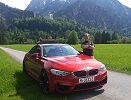 |
|
Appreciate
0
|
| 05-12-2018, 06:54 PM | #19 | ||
|
Dog Listener

701
Rep 7,850
Posts |
Quote:
I knew about Neil's Aston, and that there's quite a collection, but not the Z8 in particular. That's a special car!  If your ever in/around Northern California we do quite a few several day and simple day drives. There'd be no issue finding a BMW for you to stand in for the 335 as a trusty steed. http://www.raddrives.com/road-tours/ |
||
|
Appreciate
0
|
| 05-14-2018, 05:24 PM | #20 | |
|
Lieutenant Colonel
 946
Rep 1,910
Posts |
Quote:
Thanks much for your very kind comments about my trip reports. They're really fun to put together, and I'm glad others enjoy them, too. Good spotting on my camera change! I first started taking photos with a pre-war Kodak 35mm camera that my Dad gave me when I turned 18. It was so old that it wasn't even a rangefinder. You had to guess at distance (for focus) and exposure. Still, it got me started. From there, I was a dedicated Nikon guy for the balance of my film years. Then Canon, as you know. I was really reluctant to try something other than a Canon, but the Sony A6300 spec's were so good, I gave it a shot. I'm not disappointed--but I do miss that beautiful Canon color mix. And the 40x zoom lens. And the super macro capabilities. If Canon ever makes a superzoom camera with an APC sensor, I'll be back in a flash! I'm glad you've still got your Z4 M Roadster. The new M4 sounds like a trip and a half as well! My 335i is now 4 years old, and, after some debate, I bought a 3-year BMW factory extended warranty. I've been tempted to try something newer, but the 335i just does everything so well, I can't justify the expenditure for a 435i convertible, used 640i, or something similar. Thanks for your well-wishes. I'm hoping to get in many more trips before I can no longer figure out where I am! Rick |
|
|
Appreciate
0
|
| 05-14-2018, 05:28 PM | #21 | |
|
Lieutenant Colonel
 946
Rep 1,910
Posts |
Quote:
Neil and I had a lot of fun while he was putting his collection together, discussing what the best choices would be, trading articles, and so forth. I'm overdue to go out and visit his "Hallowed Bubba Cave" where he keeps his cars and his office, so maybe I'll get to try out some of those California drives! Rick |
|
|
Appreciate
1
Finnegan701.00 |
| 05-14-2018, 08:46 PM | #22 | |
|
///Multiple

2992
Rep 4,243
Posts
Drives: M4 Coupe | M3 | Z4M Roadster
Join Date: Jan 2011
Location: San Diego, CA
iTrader: (1)
Garage List 2006 BMW Z4 M Roadster [8.81]
2016 BMW M4 Coupe ( ... [10.00] 2018 BMW M3 (Euro D ... [0.00] 2011 BMW 335is Coup ... [10.00] |
Quote:
Since then, here's a list of everything that was covered by the extended warranty:
__________________
The Coupe: 2016 M4 | Sakhir Orange | Black Full Merino Leather | CF Trim | M-DCT | More | ED 5/13/16
The Sedan: 2018 M3 | San Marino Blue | Black Full Merino Leather | CF Trim | M-DCT | ZCP | ED 7/18/18 The Roadster: 2006 Z4  | Interlagos Blue | Black Extended Nappa Leather | Carbon Leather Trim | Purchased 7/19/12 | Interlagos Blue | Black Extended Nappa Leather | Carbon Leather Trim | Purchased 7/19/12 Last edited by SD ///M4; 05-15-2018 at 10:40 AM.. |
|
|
Appreciate
0
|
Post Reply |
| Bookmarks |
| Thread Tools | Search this Thread |
|
|